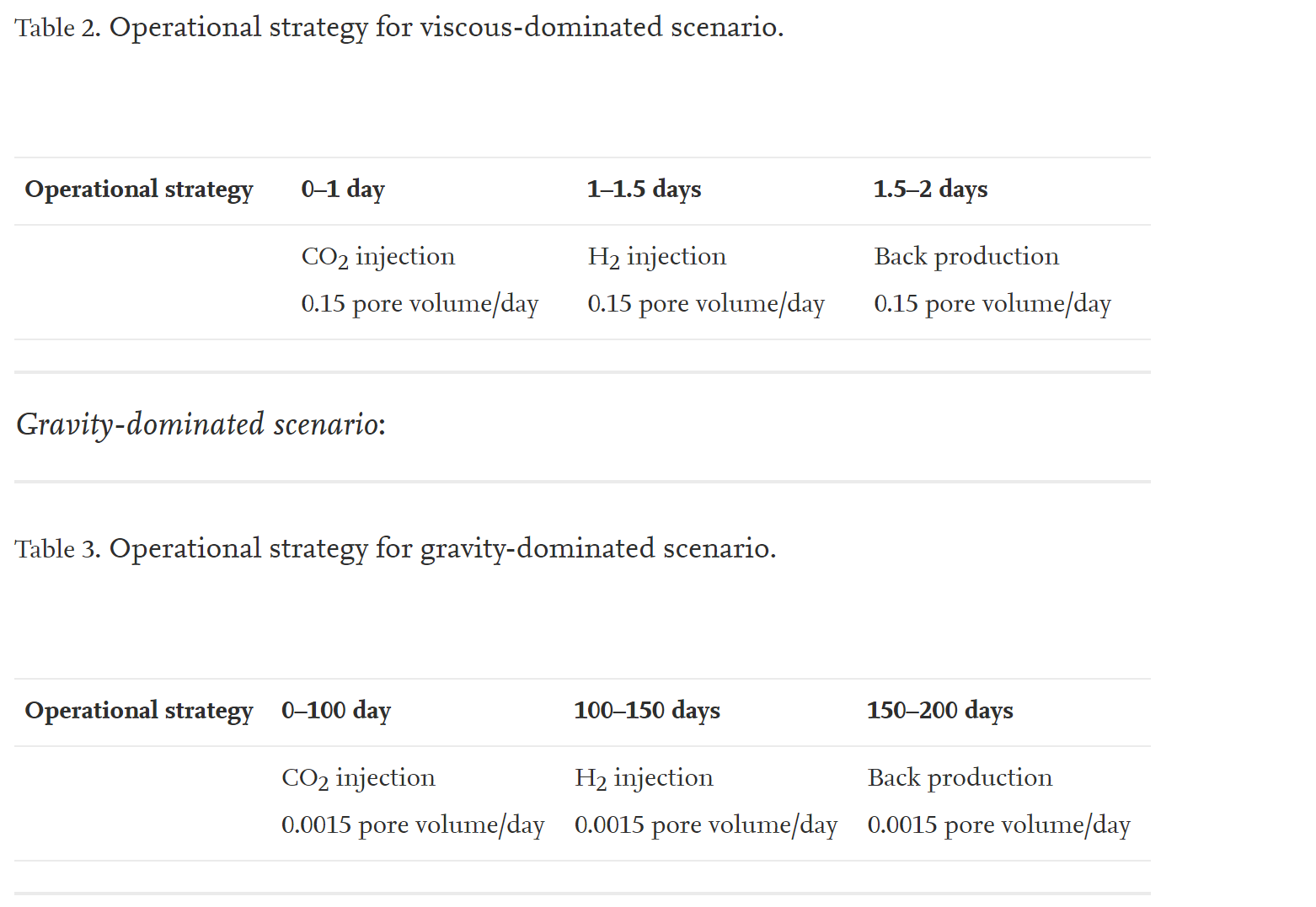Numerical modelling of H2 storage with cushion gas of CO2 in subsurface porous media: Filter effects of CO2 solubility
本研究的中心目标是提高对氢气(H2)在含有二氧化碳(CO2)垫气的地下多孔介质中储存期间的流动行为的理解。在本研究中,我们研究了驱动流动行为的各种因素之间的相互作用,包括底层渗透率的非均质性、粘度不稳定性以及粘滞力和重力之间的平衡。特别是,我们研究了CO2在水中的溶解度对H2纯度水平的影响。这一效应首次在氢气储存环境中得到证明。我们以十分精细的网格尺寸(0.1 m),在分米尺度上进行了一系列2D垂直截面模拟,以详细捕捉流动行为。这是因为在这种尺度下,注入流体和天然流体之间的大部分混合发生在物理多孔介质中。
研究发现,CO2溶解度可能对H2回采有不同的(积极和消极)影响(即,对产出H2的纯度),具体取决于系统中的流态。在以粘性为主的区域,在注氢期间,粘性较小的H2可能渗入并绕过CO2垫气。由于之前绕流的CO2的合采,这导致在采出H2时,H2纯度迅速大幅降低。有趣的是,考虑到CO2在水中的溶解度,H2中的杂质水平要低得多。这是因为绕流的CO2会重新溶解到绕过区域周围的水中,这会大大阻碍CO2向生产井的运移。在重力主导的情况下,H2聚集在模型顶部,以几乎活塞式的方式置换底层垫气。在这种以重力为主的情况下,约58%的H2可以在纯度高于98%(ISO规定的燃烧要求)的情况下回采。然而,当考虑CO2溶解度时,H2采出效果略有下降。这是因为在注入H2期间,溶解的CO2也会逐渐蒸发,这会导致CO2和H2混合区的扩大。这反过来又会缩短回采生产期间H2纯度高(>98%)的时间。
Abstract
The central objective of this study is to improve the understanding of flow behaviour during hydrogen (H2) storage in subsurface porous media, with a cushion gas of carbon dioxide (CO2). In this study, we investigate the interactions between various factors driving the flow behaviour, including the underlying permeability heterogeneity, viscous instability, and the balance between the viscous and gravity forces. In particular, we study the impact of CO2 solubility in water on the level of H2 purity. This effect is demonstrated for the first time in the context of H2 storage. We have performed a range of 2D vertical cross-sectional simulations at the decametre scale with a very fine cell size (0.1 m) to capture the flow behaviour in detail. This is done since it is at this scale that much of the mixing between injected and native fluids occurs in physical porous media.
It is found that CO2 solubility may have different (positive and negative) impacts on the H2 recovery performance (i.e., on the purity of the produced H2), depending on the flow regimes in the system. In the viscous dominated regime, the less viscous H2 may infiltrate and bypass the cushion gas of CO2 during the period of H2 injection. This leads to a quick and dramatic reduction in the H2 purity when back producing H2 due to the co-production of the previously bypassed CO2. Interestingly, the impurity levels in the H2 are much less severe in the case when CO2 solubility in water is considered. This is because the bypassed CO2 will redissolve into the water surrounding the bypassed zones, which greatly retards the movement of CO2 towards the producer. In the gravity dominated scenario, H2 accumulates at the top of the model and displaces the underlying cushion gas in an almost piston-like fashion. Approximately 58% of H2 can be recovered at a purity level above 98% (combustion requirements by ISO) in this gravity-dominated case. However, when CO2 solubility is considered, the H2 recovery performance is slightly degraded. This is because the dissolved CO2 is also gradually vaporised during H2 injection, which leads to an expansion of mixing zone of CO2 and H2. This in turn reduces the period of high H2 purity level (>98%) during back-production.

Fig. 1. The correlated heterogeneous permeability field used in this work.


Fig. 10. Gas saturations and mole fractions of H2 at the end of each cycle of the base model without CO2 solubility (Case E at the top) and the case with CO2 solubility (Case F at the bottom).
